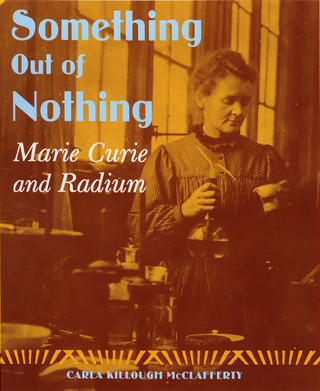Something Out of Nothing: Marie Curie and Radium
Marie Curie overcame discrimination, poverty, and oppression to reach her goal of becoming a scientist--then she changed the world.

LESSON PLANS FOR SOMETHING OUT OF NOTHING
REVIEWS FOR SOMETHING OUT OF NOTHING: MARIE CURIE AND RADIUM
School Library Journal
***** STARRED REVIEW *****
*MCCLAFFERTY, Carla Killough. Something Out of Nothing: Marie Curie and Radium.
Gr 5-7-The author of The Head Bone's Connected to the Neck Bone: The Weird, Wacky and Wonderful X-Ray (Farrar, 2001) takes on a related topic with equal success in this profile of the driven scientist most closely associated with the discovery of radium. Born Manya Sklodowska and educated in her native Poland at a "Floating University" that operated in defiance of harsh Russian policies, Curie moved to Paris to continue her studies. There, both before and after the tragic death of her beloved, kindred spirit Pierre, she dedicated her life to pure research and enlisted her father-in-law to care for her children. She never took out patents, so even as she was rising to international fame, entrepreneurs worldwide began trumpeting wild claims for the healing benefits of radioactive products. McClafferty chronicles both that fad-and its dismal outcome, as the effects of long-term radiation poisoning slowly became horribly apparent. Noting that Curie maintained lifelong ties with her native land and also did significant medical work in WWI, the author follows her career to its final, illness-ridden days, then ends with an apt summation of her legacy. Archival photos and substantial multimedia resource lists enhance an engrossing study of a great scientist who tried to turn away from the world and ended up changing it profoundly.-John Peters, New York Public Library
Booklist
McClafferty, Carla Killough. Something Out of Nothing: Marie Curie and Radium.
Gr. 7-10. Like Nick Healy's overview, Marie Curie (2005), this readable biography examines Curie's life and work as a groundbreaking scientist and as an independent woman. Unlike Healy's, though, McClafferty's account is more detailed and includes extensive documentation with chapter source notes. The groundbreaking is as thrilling as the personal story, which describes Curie's struggle to get to college, her happy marriage to Pierre Curie and their work together, and her recognition as the first woman to win a Nobel Prize, a prize she won again later for her work in chemistry. In addition to the triumph, though, McClafferty shows that Curie could be harsh and indifferent to her own family. The spacious design makes the text easy to read, and occasional photos, including one of the interior of the shed where she and Pierre began their groundbreaking work, bring the story closer to readers. --Hazel Rochman
Kirkus
An able biography tells, as the subtitle suggests, the stories of both Marie Curie and her famous discovery. After a précis of Curie's childhood that relies a little too much on daughter Eve's hagiography, the narrative settles, in measured fashion, on the great scientist's pioneering work, first with husband Pierre and then without. Liberal use of primary source material gives readers a terrific sense of Curie's state of mind as she worked and loved, archival illustrations taking them into the Curies' lab and notebooks. Later chapters intersperse the account of Curie's life with the meteoric rise and fall of the fortunes of radium, her most famous discovery, drawing heavily on both contemporary news coverage and advertising to demonstrate the near total embrace of radium as a cure-all. Accounts of groundbreaking radiation therapy give way to the travails of the "Radium Girls"-women whose repeated exposure to radium in the paint they used for glow-in-the-dark watches proved fatal. There are many biographies of Curie; this one stands out in its shared focus on her discovery and its legacy. (notes, bibliography, web sites, index) (Biography. 10-14)
The Bulletin of the Center for Children’s Books (BCCB)
Perhaps no scientific career stands in greater contrast to that of Isaac Newton (see Krull, above) than that of Marie Curie. Newton experienced his annus mirabilis at twenty-four, the age at which Marie was finally able to enroll in college. While Newton worked as a sort of lone wolf, Marie and husband Pierre collaborated so closely they shared notebooks and carefully credited each other's efforts in their public lectures. While Newton hoarded his work, jealous of retaining appropriate credit for his discoveries, the Curies never patented their work, believing that the element radium was the "property" of humankind. In her smooth-moving text, McClafferty not only covers expected biographical data but also contrasts Curie's dedication to the study of radioactive elements with the exploitation of radium by the established medical community and a host of quacks and snake-oil salesmen as a silver-bullet cure for most ailments. As applications moved in advance of understanding, reputable scientists (the Curies included) as well as a gullible public freely placed themselves in the path of debilitating or even lethal exposure to radiation. Thus, biography melds here with social history to present Marie Curie as both shaper of and subject to the limits of early twentieth-century science. Generously illustrated with black-and-white photos, medical realia, and document reproductions, the volume also includes source notes, a selected bibliography, index, and annotated list of websites. EB